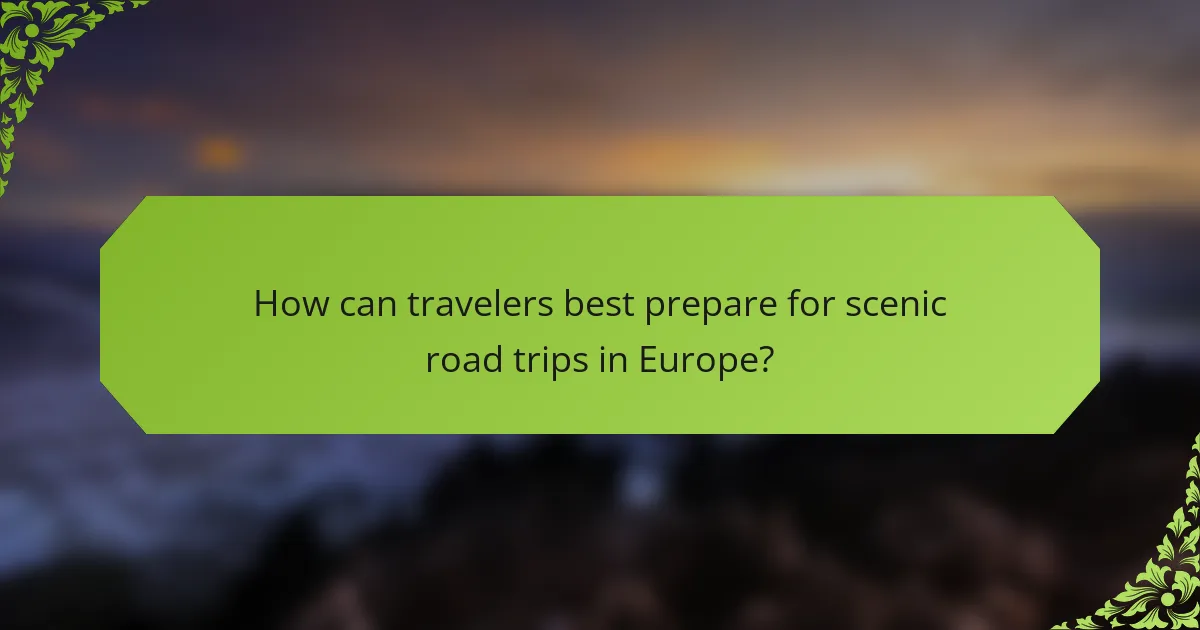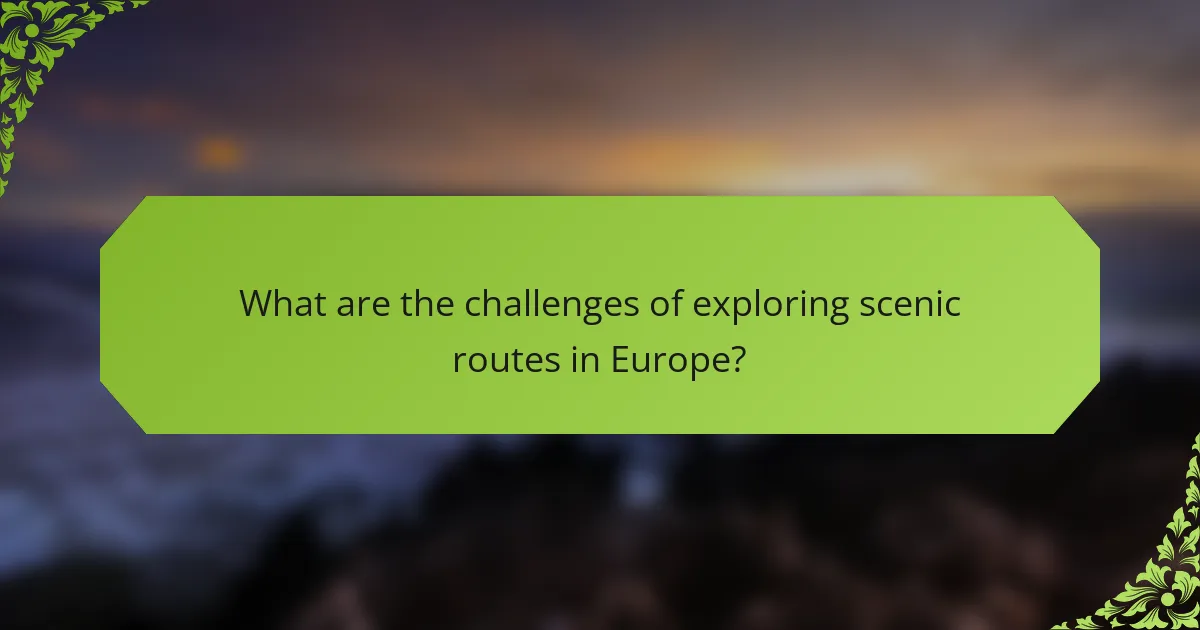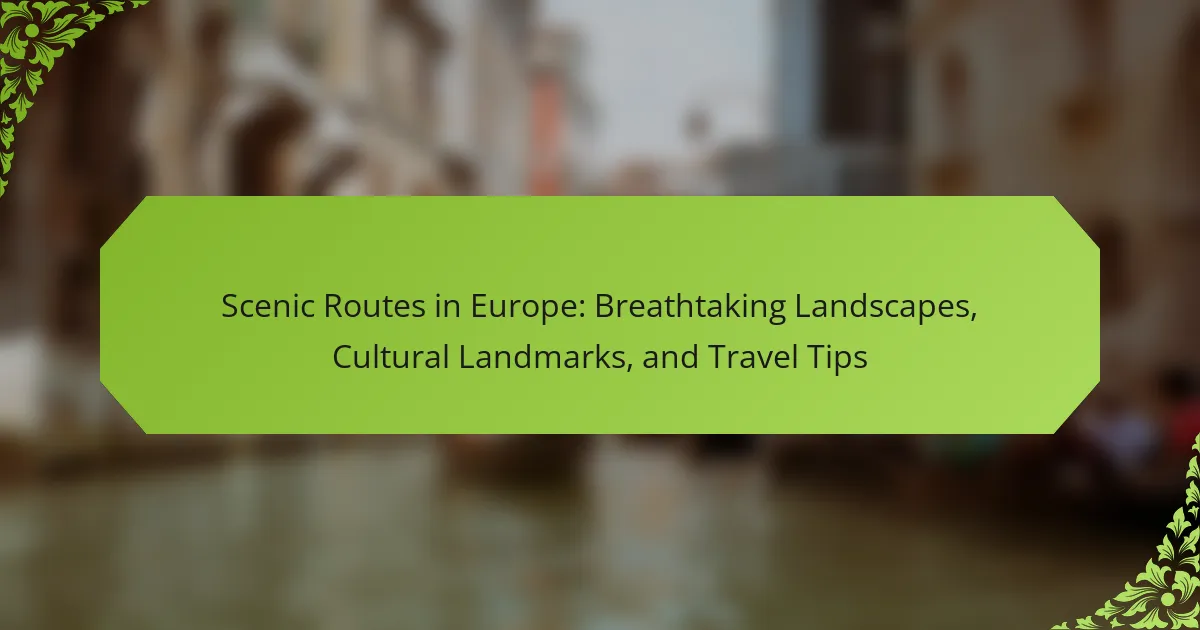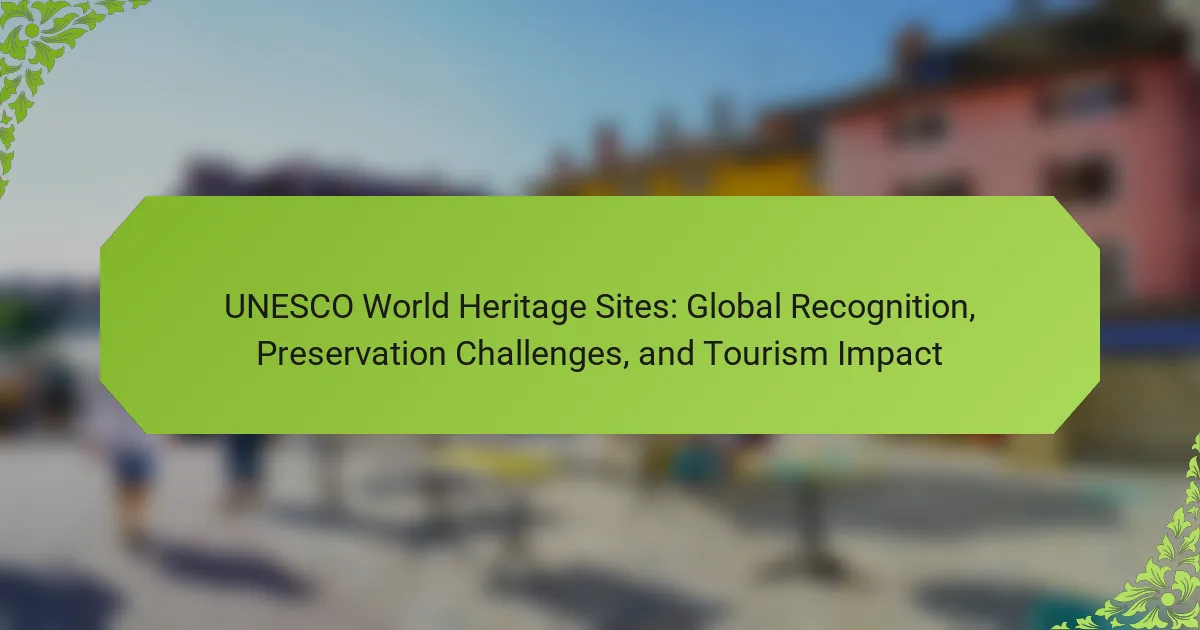Discover breathtaking landscapes and cultural landmarks along Europe’s most scenic routes. Explore iconic destinations like the Amalfi Coast, the Ring Road in Iceland, and Germany’s Romantic Road. Prepare for your journey with essential travel tips and insights into local cuisine. Experience the perfect blend of natural beauty and rich history on these unforgettable road trips.

What are the most scenic routes in Europe?
Some of the most scenic routes in Europe include the Amalfi Coast in Italy, the Ring Road in Iceland, and the Romantic Road in Germany. These routes offer stunning landscapes, charming villages, and rich cultural experiences.
The Amalfi Coast features dramatic cliffs and picturesque coastal towns. The Ring Road circles Iceland, showcasing waterfalls, glaciers, and volcanic landscapes. The Romantic Road highlights medieval towns and castles in Bavaria.
Travel tips for these routes include planning for seasonal weather, allowing time for exploration, and considering local cuisine. Each route provides a unique blend of natural beauty and cultural landmarks, making them ideal for travelers seeking memorable experiences.
How do landscapes vary across different European regions?
Landscapes across European regions vary significantly, showcasing diverse natural beauty and cultural landmarks. Each region offers unique scenic routes that highlight its geographical features and historical significance. For instance, the Alps in Central Europe present stunning mountain vistas, while the Mediterranean coastline features picturesque beaches and charming villages. The rolling hills of Tuscany in Italy contrast with the rugged cliffs of Ireland, creating a rich tapestry of landscapes. Travelers can explore these variations through well-planned scenic routes that enhance their experience and appreciation of Europe’s cultural heritage.
Which routes are known for their cultural significance?
Several scenic routes in Europe are renowned for their cultural significance. The Romantic Road in Germany showcases medieval towns and castles, while the Ring of Kerry in Ireland offers a glimpse into ancient heritage and stunning landscapes. The Amalfi Coast in Italy is famous for its picturesque villages and rich history. Additionally, the Route des Grands Crus in France highlights exquisite vineyards and culinary traditions. Each route provides a unique blend of breathtaking scenery and cultural landmarks, enhancing the travel experience.

What are the essential attributes of a breathtaking scenic route?
The essential attributes of a breathtaking scenic route include stunning landscapes, cultural landmarks, and accessibility. Scenic routes in Europe often feature diverse terrains, from mountains to coastlines, providing visual variety. Cultural landmarks enhance the experience, offering historical context and local charm. Accessibility ensures travelers can enjoy these routes comfortably, with well-maintained roads and amenities.
How do natural features enhance the travel experience?
Natural features significantly enhance the travel experience by providing stunning visuals and cultural depth. Scenic routes in Europe, like the Amalfi Coast and the Ring of Kerry, showcase breathtaking landscapes alongside historical landmarks. Travelers often find that these natural settings offer unique opportunities for photography, relaxation, and exploration. For instance, the picturesque views along these routes can evoke a sense of tranquility, making the journey itself a memorable part of the adventure. Additionally, local cultures and traditions enrich the experience, allowing travelers to connect with the region’s heritage while enjoying its natural beauty.
What role do historical landmarks play in scenic routes?
Historical landmarks enhance scenic routes by offering cultural insights and visual appeal. They serve as points of interest that enrich the travel experience, drawing visitors to explore local history and architecture. For example, driving through Tuscany, travelers encounter medieval castles and ancient ruins that tell the story of the region. These landmarks create memorable stops, encouraging exploration and appreciation of the landscape. Their unique attributes, like architectural style and historical significance, contribute to the overall allure of scenic routes in Europe.

How can travelers best prepare for scenic road trips in Europe?
Travelers can best prepare for scenic road trips in Europe by planning their routes, packing essentials, and researching local attractions. Prioritize popular scenic routes like the Amalfi Coast or Ring Road in Iceland for breathtaking views.
1. Choose your scenic route based on landscapes and cultural landmarks.
2. Pack necessary items such as maps, snacks, and a first-aid kit.
3. Research local attractions and hidden gems along your route.
4. Allocate time for spontaneous stops to explore unique sites.
5. Consider the best travel seasons to avoid crowds and enjoy favorable weather.
What are the top travel tips for navigating European scenic routes?
To navigate European scenic routes effectively, prioritize planning, safety, and flexibility. Research routes in advance, focusing on breathtaking landscapes and cultural landmarks. Use local apps for navigation and real-time updates. Consider off-peak travel times to avoid crowds. Always check weather conditions and pack accordingly. Engage with locals for hidden gems and recommendations.
Which seasonal considerations should travelers keep in mind?
Travelers should consider seasonal weather, local events, and landscape changes when exploring scenic routes in Europe. Spring offers blooming flowers and mild weather, while summer provides vibrant festivals. Autumn showcases colorful foliage, and winter reveals snow-covered vistas. Each season enhances unique cultural landmarks and travel experiences.

What unique experiences can be found along specific routes?
Scenic routes in Europe offer unique experiences like stunning landscapes, historical landmarks, and cultural insights. For instance, the Amalfi Coast route in Italy features dramatic cliffs and charming villages, while the Ring Road in Iceland showcases volcanic landscapes and waterfalls. The Romantic Road in Germany provides a glimpse into fairy-tale castles and medieval towns. Each route presents opportunities for local cuisine and traditions, enhancing the travel experience. Exploring these routes not only reveals breathtaking visuals but also deepens cultural appreciation.
How do local festivals and events enrich the journey?
Local festivals and events significantly enhance the travel experience by offering unique cultural insights and memorable interactions. They showcase regional traditions, culinary delights, and artistic expressions, making journeys more enriching. For instance, attending a local harvest festival in Tuscany allows travelers to taste authentic wines and local dishes while enjoying live music and art exhibitions. This immersive experience connects visitors with the community and landscape, deepening their appreciation for the destination’s culture. Engaging in such events can transform a scenic route into a vibrant adventure filled with unforgettable moments.
What culinary delights await travelers on these scenic paths?
Travelers on scenic routes in Europe can enjoy diverse culinary delights that reflect local traditions and flavors. Each region offers unique dishes, from fresh seafood along the Mediterranean coast to hearty mountain fare in the Alps. For instance, Italy’s Amalfi Coast features exquisite limoncello and fresh pasta, while France’s Loire Valley is known for its fine wines and goat cheeses. Exploring local markets and dining at family-run restaurants enhances the culinary experience, allowing travelers to savor authentic regional specialties.

What are the challenges of exploring scenic routes in Europe?
Exploring scenic routes in Europe presents challenges such as unpredictable weather, narrow roads, and limited services. These factors can affect travel plans and safety. Additionally, some routes may be congested during peak seasons, impacting the overall experience. Travelers should prepare for varying road conditions and consider alternative routes to enhance their journey.
How can travelers overcome common obstacles?
Travelers can overcome common obstacles by planning ahead, being flexible, and embracing local cultures. Research scenic routes in Europe to identify breathtaking landscapes and cultural landmarks. Use travel apps for real-time updates and recommendations. Engage with locals for tips on hidden gems and avoid peak tourist times for a more authentic experience.
What safety tips should be followed while driving?
To drive safely on scenic routes in Europe, follow these essential tips. Always stay alert for changing road conditions and wildlife. Use GPS for navigation, ensuring you take the best routes while avoiding distractions. Keep a safe distance from other vehicles, especially on winding roads. Familiarize yourself with local traffic laws, as they may differ from your home country. Lastly, plan for breaks to enjoy the breathtaking landscapes and cultural landmarks without rushing.

What are the best practices for sustainable travel on scenic routes?
To practice sustainable travel on scenic routes, prioritize eco-friendly transportation, respect local cultures, and minimize waste. Choose public transport or cycling to reduce carbon footprints. Engage with local communities to support their economies and preserve cultural landmarks. Carry reusable items to limit plastic use.
How can travelers minimize their environmental impact?
Travelers can minimize their environmental impact by choosing sustainable modes of transport, such as trains or buses, instead of flying. They can also prioritize eco-friendly accommodations that support local communities and use renewable resources. Engaging in low-impact activities, like hiking or cycling, helps preserve the natural landscape. Additionally, travelers should respect local cultures and wildlife, ensuring their presence does not disrupt the environment. Finally, reducing waste by using reusable items contributes significantly to sustainability while exploring scenic routes in Europe.
What resources are available for eco-friendly travel planning?
Various resources support eco-friendly travel planning in Europe. Online platforms like EcoTourism.org provide insights on sustainable destinations. Apps such as Green Travel Guide offer eco-friendly routes, while websites like Responsible Travel focus on ethical experiences. Additionally, local tourism boards often promote green initiatives and sustainable accommodations. Engaging with these resources enhances awareness of eco-conscious choices while exploring breathtaking landscapes and cultural landmarks across Europe.
What common mistakes should travelers avoid when exploring scenic routes?
Travelers should avoid common mistakes like rushing through scenic routes, neglecting local culture, and failing to plan for weather changes. Prioritize enjoying the journey rather than just the destination. Researching local attractions and dining options enhances the experience. Lastly, ensure your vehicle is well-prepared for diverse terrains.



